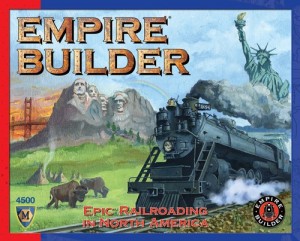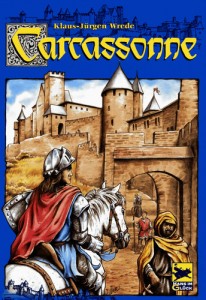Friday we looked at Empire Builder; a great classic from 1982 that brought the Crayon Rails mechanic into the mainstream. The mechanic is traced on BoardGameGeek back to 1973 with the game Railway Rivals. As of when I wrote this blog BGG has 80 games listed as using the Crayon Rail System; most of which, however, are additional maps for Railway Rivals or games in the Empire Builder series. The last decade, however, has shown potential promise, mostly in the indie communities, of this mechanic expanding.
So what is the Crayon Rails System? How does it work? In which ways does it influence themes or partnered mechanics? These are all questions that I imagine a variety of readers are asking simply due to the smaller scale of exposure Crayon Rails has in comparison to mechanics...
Tag Archives: game
Favorite Fridays – Empire Builder
I love trains and by proxy I love train games; some of the time. Not all train games are created equal, and while I have not player all train games in existence I have my favorites, one of which is Empire Builder.
Released: 1982
Designer: Darwin Bromley and Bill Fawcett
Plays: 2-6
EPT: 180 minutes
Using the Crayon Rails System players spread their locomotive dominance across North America attempting to move goods and passengers across Mexico, the United States, and Canada. The first player to end their turn with 6 of the 7 major cities connected to one continuous railroad while holding 250 million in cash is declared the winner.
Before play begins each player is given a colored pawn, a crayon of a matching color, a train with a speed...
love trains and by proxy I love train games; some of the time. Not all train games are created equal, and while I have not player all train games in existence I have my favorites, one of which is Empire Builder.
Released: 1982
Designer: Darwin Bromley and Bill Fawcett
Plays: 2-6
EPT: 180 minutes
Using the Crayon Rails System players spread their locomotive dominance across North America attempting to move goods and passengers across Mexico, the United States, and Canada. The first player to end their turn with 6 of the 7 major cities connected to one continuous railroad while holding 250 million in cash is declared the winner.
Before play begins each player is given a colored pawn, a crayon of a matching color, a train with a speed...
 love trains and by proxy I love train games; some of the time. Not all train games are created equal, and while I have not player all train games in existence I have my favorites, one of which is Empire Builder.
Released: 1982
Designer: Darwin Bromley and Bill Fawcett
Plays: 2-6
EPT: 180 minutes
Using the Crayon Rails System players spread their locomotive dominance across North America attempting to move goods and passengers across Mexico, the United States, and Canada. The first player to end their turn with 6 of the 7 major cities connected to one continuous railroad while holding 250 million in cash is declared the winner.
Before play begins each player is given a colored pawn, a crayon of a matching color, a train with a speed...
love trains and by proxy I love train games; some of the time. Not all train games are created equal, and while I have not player all train games in existence I have my favorites, one of which is Empire Builder.
Released: 1982
Designer: Darwin Bromley and Bill Fawcett
Plays: 2-6
EPT: 180 minutes
Using the Crayon Rails System players spread their locomotive dominance across North America attempting to move goods and passengers across Mexico, the United States, and Canada. The first player to end their turn with 6 of the 7 major cities connected to one continuous railroad while holding 250 million in cash is declared the winner.
Before play begins each player is given a colored pawn, a crayon of a matching color, a train with a speed...
Worker Wednesday – Bremerhaven
 Last week on Worker Wednesday we looked at a game that splits the fence on if it counts as worker placement game in Castles of Burgundy; this week I will continue in the world of ambiguity; why? Because some men just want to watch the world burn… So let us look at Bremerhaven and ask the question is it really a worker placement game?
Released 2013
Designer: Robert Auerochs
Plays: 1-4
EPT: 90 minutes
Bremerhaven gives players the chance to take on the position of a harbor manager controlling the incoming and outgoing of goods with the end goal of having the highest score once the final round is over; this score is calculated by multiplying your remaining money by your harbor’s prestige.
The game takes place on three main boards; water,...
Last week on Worker Wednesday we looked at a game that splits the fence on if it counts as worker placement game in Castles of Burgundy; this week I will continue in the world of ambiguity; why? Because some men just want to watch the world burn… So let us look at Bremerhaven and ask the question is it really a worker placement game?
Released 2013
Designer: Robert Auerochs
Plays: 1-4
EPT: 90 minutes
Bremerhaven gives players the chance to take on the position of a harbor manager controlling the incoming and outgoing of goods with the end goal of having the highest score once the final round is over; this score is calculated by multiplying your remaining money by your harbor’s prestige.
The game takes place on three main boards; water,...
Hitman Holiday – Now on Kickstarter!
Follow Up Tuesday – Zombie House
Yesterday we looked at the mechanic of Simultaneous Action Selection and today we will follow that up with the game Zombie House. While the theme of zombies is one I have seen done more than almost anything aside from farming the european countryside and trading in the mediterranean this is a game well worth a look. (Note: This review will be looking at ‘Zombie House - Beta’ there is another version available on Game Crafter without the beta tag that plays the same but has slightly different components.)
Released: 2014
Designers: Mars Needs Games
Plays: 2-8
EPT: 30-60 minutes
Zombie House is an independently designed game produced via Print on Demand through The Game Crafter. Being an independent game there are noticeable aspects that can be nagged on such as a lower art quality and simpler components; but the game’s...
Mechanic Monday – Simultaneous Action Selection
Friday I looked at 7 Wonders which uses the mechanics of Card Drafting, Set Collection, Variable Player Powers, and Simultaneous Action Selection. Today we will take a look at the last of those mechanics; I will state first that I feel the name is slightly misleading as the simultaneous aspect of these games is not always action related; I will also refer to the mechanic as SAS as Simultaneous Action Selection.
Simultaneous Action Selection is an interesting mechanic as it serves multiple purposes from forcing players to plan ahead, increasing a game’s pace, to minimizing downtime between turns. The mechanic is is one that can be utilized in a variety of ways when partnered with other mechanics. Often SAS will be used as a part of a turn round in which players manage minor upkeep, turn...
Wild Card Thursday – Bang!
 Those who know me know there are certain games and mechanics I generally don’t enjoy; some of those being player elimination and larger group games, there are of course exceptions to the rule and Bang! is one of those exceptions.
Released: 2002
Designers: Emiliano Sciarra
Plays: 4-7
EPT: 30 minutes
Bang! is a social deduction, card, hand management, player elimination game in which players take on the rolls of cops and robbers in a spaghetti western. The rules of Bang! are fairly simple yet often altered; I will thus explain the rules and add any additional house rules my group prefers in parentheses; I also played with the early print runs pre-bullet and pre-re-reprint and this the components may vary slightly.
The game has four roles the players take up at random...
Those who know me know there are certain games and mechanics I generally don’t enjoy; some of those being player elimination and larger group games, there are of course exceptions to the rule and Bang! is one of those exceptions.
Released: 2002
Designers: Emiliano Sciarra
Plays: 4-7
EPT: 30 minutes
Bang! is a social deduction, card, hand management, player elimination game in which players take on the rolls of cops and robbers in a spaghetti western. The rules of Bang! are fairly simple yet often altered; I will thus explain the rules and add any additional house rules my group prefers in parentheses; I also played with the early print runs pre-bullet and pre-re-reprint and this the components may vary slightly.
The game has four roles the players take up at random...
Worker Wednesday – Castles of Burgundy
 Worker Wednesday; the day of the week we get to enjoy the games using Worker Placement as a key mechanic. Today, however, we mix it up as we look at a game that many would not consider a Worker Placement game, but I am not one of the many. I am, however, right…. or at least I think I am; the game, Castles of Burgundy.
Released 2011
Designer: Stefan Feld
Plays: 2-4
EPT: 90 minutes
Before I explain why I consider Castles of Burgundy to be a worker placement game let me explain the way the game plays.
In Castles of Burgundy players are seeking to earn the most points by developing their estate and developing it with fields, castles, mines, and learning. The game plays on a...
Worker Wednesday; the day of the week we get to enjoy the games using Worker Placement as a key mechanic. Today, however, we mix it up as we look at a game that many would not consider a Worker Placement game, but I am not one of the many. I am, however, right…. or at least I think I am; the game, Castles of Burgundy.
Released 2011
Designer: Stefan Feld
Plays: 2-4
EPT: 90 minutes
Before I explain why I consider Castles of Burgundy to be a worker placement game let me explain the way the game plays.
In Castles of Burgundy players are seeking to earn the most points by developing their estate and developing it with fields, castles, mines, and learning. The game plays on a...
Follow Up Tuesday – Carcassonne
 In yesterday’s post we looked at the mechanic of Tile Placement; today we will take a closer look at how that mechanic plays out in Carcassonne.
Released: 2000
Designers: Klaus-Jurgen Wrede
Plays: 2-5
EPT: 45 minutes
As is the usual we will only look at the base game of Carcassonne and save the expansions for a latter date, and for Carcassonne the expansions are many. I was first introduced to Carcassonne while in high school. My mother received the game as a gift asking for it as she thought it looked interesting. We quickly read the rules and began playing; all four of the players new to the game we each developed strategies as the game progressed. When the game ended we were eager to start over with our newly developed...
In yesterday’s post we looked at the mechanic of Tile Placement; today we will take a closer look at how that mechanic plays out in Carcassonne.
Released: 2000
Designers: Klaus-Jurgen Wrede
Plays: 2-5
EPT: 45 minutes
As is the usual we will only look at the base game of Carcassonne and save the expansions for a latter date, and for Carcassonne the expansions are many. I was first introduced to Carcassonne while in high school. My mother received the game as a gift asking for it as she thought it looked interesting. We quickly read the rules and began playing; all four of the players new to the game we each developed strategies as the game progressed. When the game ended we were eager to start over with our newly developed...
Mechanic Monday – Tile Placement
Some mechanics are moderately new as the hobby of gaming grows and adapts to new players, themes, and play styles. Other mechanics, however, seem to have existed since the hobby’s creation. Tile placement is one of the latter.
According to Board Game Geek The mechanic of Tile Placement has arguably existed since 1120 with Chinese Dominoes. The year can be up for debate; but the idea that Dominoes is a tile placement game is clear making this one of the older mechanics that is still used in modern gaming.
A vast majority of games that utilize Tile Placement involve matching parts of the tile to other parts already in play. In Carcassonne players must keep roads attached to roads; castle walls to castle walls, fields to fields, rivers to rivers, etc. Similarly in Alhambra players...

